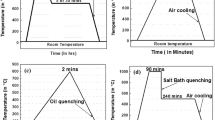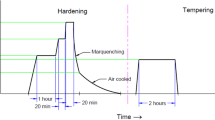Abstract
Hot-working die steel should possess good high temperature strength, tempering resistance, ductility and reasonable cost. Thus, H13 is widely used for forging, extrusion and die casting. Resistance to surface wear of hot working die steel plays an important role in imparting good finish to the products. The properties required of hot die steel for a given application can be obtained by controlling heat treatment parameters which produces major changes in microstructure. This paper intends to find the impact of austenitizing temperature, tempering temperature and tempering time on the wear behavior of H13 die steel. After heat treating samples at austenitizing temperature of 1020, 1040 and 1060\(^{\circ }\)C; tempering temperature 540, 560 and 580\(^{\circ }\)C; tempering time 1, 2 and 3 h, experimentation on pin-on-disc tribotester is done to measure the H13 die steel sliding wear and coefficient of friction. Using Box–Behnken design a response surface method model is developed to find the impact of above heat treatment parameters and the adequacy of model is verified through the analysis of variance (ANOVA) technique. The optimized heat treatment set predicted by desirability function approach is verified experimentally and the results are found close to the predicted results.













Similar content being viewed by others

References
Luong LHS, Heijkoop T (1981) The influence of scale on friction in hot metal working. Wear 71(1):93–102
Barrau O, Boher C, Gras R, Aria FR (2003) Analysis of the friction and wear behaviour of hot work tool steel for forging. Wear 255(712):1444–1454
Podgornik B, Zuzek B, Kafexhiu F, Leskovsek V (2016) Effect of Si content on wear performance of hot work tool steel. Tribol Lett 65(5):1–10
Abouei V, Saghafian H, Kheirandish S (2007) Dry sliding oxidative wear in plain carbon dual phase steel. J Iron Steel Res Int 14(4):43–48
Chandler H (1998) Heat treater’s guide: practices and procedures for irons and steels, 2nd edn. ASM International
ASM handbook volume 4—heat treating. ASM International
Speich GR, Leslie WC (1972) Tempering of steel. Metall Trans 3:1043–1054
Wei MX, Wang SQ, Wang L, Cui XH, Chen KM (2011) Effect of tempering conditions on wear resistance in various wear mechanisms of H13 steel. Tribol Int 44(78):898–905
Bahrami A, Anijdan SHM, Golozar MA, Shamanian M, Varahram N (2005) Effects of conventional heat treatment on wear resistance of AISI H13 tool steel. Wear 258(56):846–851
Cui XH, Wang SQ, Wei MX, Yang ZR (2011) Wear characteristics and mechanisms of H13 steel with various tempered structures. J Mate Eng Perform 20(6):1055–1062
Prasad SN, Mediratta SR, Sarma DS (2003) Influence of austenitisation temperature on the structure and properties of weather resistant steels. Mater Sci Eng A 358(12):288–297
Fadare DA, Fadara TG, Akanbi OY (2011) Effect of heat treatment on mechanical properties and microstructure of NST 37-2 steel. J Miner Mater Charact Eng 10(3):299–308
Krishna SC, Srinath J, Jha AK, Pant B, Sharma SC, George KM (2013) Effect of heat treatment on microstructure and mechanical properties of 12Cr-10Ni-0.25Ti-0.7Mo stainless steel. Metallogr Microstruct Anal 2(4):234–241
Zhang Y, Li J, Shi CB, Qi YF, Zhu QT (2017) Effect of heat treatment on the microstructure and mechanical properties of nitrogen-alloyed high-Mn austenitic hot work die steel. Metals 7(3):1–16
Modi OP, Prasad BK, Jha AK, Dasgupta R, Yegneswaran AH (2003) Low-stress abrasive wear behaviour of a 0.2 C steel: influence of microstructure and test parameters. Tribiol Lett 15(3):249–255
Feng Y, Xu C, Bu C, Su X, Pan X, Cao Y, Chen G (2017) Research on austenitizing behavior and mechanical properties of 40CrNi2Si2MoVA steel. Adv Mater Process Technol 3(4):616–626
Malghan RL, Rao KMC, Shettigar AK, Rao SS, D’Souza RJ (2017) Application of particle swarm optimization and response surface methodology for machining parameters optimization of aluminium matrix composites in milling operation. J Braz Soc Mech Sci Eng 39:3541–3553
Manohar M, Joseph J, Selvaraj T, Sivakumar D (2013) Application of Box Behnken design to optimize the parameters for turning Inconel 718 using coated carbide tools. Int J Sci Eng Res 4(4):620–642
Montgomery DC (2012) Design and analysis of experiments design and analysis of experiments, 8th edn. Wiley
Arora VK, Bhushan G, Aggarwal ML (2017) Enhancement of fatigue life of multi-leaf spring by parameter optimization using RSM. J Brazil Soc Mech Sci Eng 39:1333–1349
Negi S, Sharma RK, Dhiman S (2015) Experimental investigation of SLS process for flexural strength improvement of PA-3200GF parts. Mate Manuf Process 30(5):644–653
Guanghua Y, Xinmin H, Yanqing W, Xingguo Q, Ming Y, Zuoming C, Kang J (2010) Effects of heat treatment on mechanical properties of h13 steel. Metal Sci Heat Treat 52(7):393–395
Zhang R, Sisson RD (2015) The influence of temperature on the Austenite grain size and microstructure of 4140 steel. In: Proceedings of the 28th ASM heat treating society conference, ASM International, pp. 368–372
Jun LY, Min LY, Yun HB (2006) Influence of austenitizing temperature on apparent morphologies of as-quenched microstructures of steels. J Cent South Univ Technol 13(2):122–129
Hansen N (2004) Hall-Petch relation and boundary strengthening. Scripta Mater 51(8):801–806
Gojic M, Kosec L, Matkovic P (1998) The effect of tempering temperature on mechanical properties and microstructure of low alloy Cr and CrMo steel. J Mater Sci 33:395–403
Kato K (2000) Wear in relation to friction—a review. Wear 241:151–157
Yuan X, Chen L, Zhao Y, Di H, Zhu F (2014) Dependence of grain size on mechanical properties and microstructures of high manganese austenitic steel. In: 11th International conference on technology of plasticity, Nagoya, Japan, vol 81, (Procedia Engineering, 2014), vol 81, pp 143–148
Olson GB (1992) Martensite. ASM International
Raghavan V, Cohen M (1971) Measurement and interpretation of isothermal martensitic kinetics. Metall Trans 2(9):2409–2418
Thelning KE (1984) Steel and its heat treatment steel and its heat treatment, 2nd edn. Butterworth-Heinemann, Oxford
Roberts G, Krauss G, Kennedy R (1998) Tool steels, 5th edn. ASM International
Acknowledgements
Authors would like to thank Mr. Baljinder Singh from heat treatment department of Central Tool Room Ludhiana (Pb), Government of India Society, Mr. Sagar Bhandari of M/s A-One metal, Mohali (Pb), and Mr. Sudhir Gupta & Mr. Arun from Industrial Development cum Facility Center of Chandigarh Industrial & Tourism Development Corporation Limited, Chandigarh, for there support during the course of heat treatment, machining and testing throughout this work.
Author information
Authors and Affiliations
Corresponding author
Additional information
Technical Editor: Francisco Ricardo Cunha.
Rights and permissions
About this article
Cite this article
Jagota, V., Sharma, R.K. Interpreting H13 steel wear behavior for austenitizing temperature, tempering time and temperature. J Braz. Soc. Mech. Sci. Eng. 40, 219 (2018). https://doi.org/10.1007/s40430-018-1140-6
Received:
Accepted:
Published:
DOI: https://doi.org/10.1007/s40430-018-1140-6



